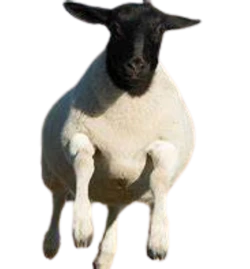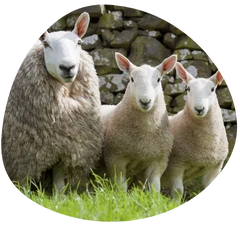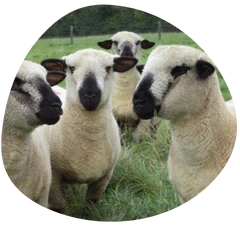Many men and women who are raising families in today’s world are finding ways to rely less on the supply chain and become more self-sufficient. There have been many times in past years when supplies were low or inflation caused the price of goods to be excessive.
Store shelves have been stripped bare of their goods in recent times, such as during the pandemic beginning in 2020. Consumers found it difficult to find meat to feed their families.
And even in the most recent news, cargo ships are sitting offshore, unable to unload the items we usually assume we can get, such as clothes made from cotton. The media have been warning Americans and citizens around the world that supplies will be scarce toward the end of 2022 and beyond.
They’re telling people to shop for their Christmas gifts early and even stock up on holiday meal items weeks ahead of time. Imagine if a true survival situation were to emerge.
Many people have begun to raise animals that can provide for them on a long term basis. They’re showing an increased interest in what it takes to raise a flock of sheep on their homestead.
Making the Decision to Raise Animals for Survival Purposes
Many people just can’t stomach the idea of raising animals for survival purposes. Although, many of those same people have no problem going into a store and buying meat products, wearing leather shoes, or putting on a cashmere sweater.
Perhaps it’s the thought of doing these things yourself that makes your stomach churn. However, in a SHTF situation, when it is you against Mother Nature, you are going to have to find a way to use animals for your survival.
Animals are good for many purposes, from providing food and milk to helping clothe your family. They can even help keep your property maintained in some instances. What you need to keep in mind is that in major events, you may not have access to certain food, clothing, and other necessities.
Raising animals is not something you only have to do in a survival situation. This is a good practice year round to allow your family to sustain their needs without relying on the supply chain.
There are many types of animals that you can raise on your property. You don’t even need to have endless acres to raise them on. These include chickens, sheep, rabbits, cows, goats, llamas, and more.
You can easily start with a small group of animals to raise and become familiar with, and then move on to larger herds and flocks that will help sustain you and your loved ones if a major event ever occurs.

Sheep and Other Animals That Provide Milk and Food for Your Family
Milk is a product that most consumers use daily. We put it in our coffee, pour it over our cereal, and use it in many recipes. It’s an ingredient that we often take for granted.
Traditionally, to purchase milk, we simply walk into a grocery store and buy a gallon whenever it suits us. There are factories that handle the production of milk on a large scale basis.
The milk that you usually buy in a store is refrigerated in convenient packaging whenever you need it. However, in a survival situation, it may not be as easy to come by.
There are many survival preppers who rely on powder based milk options, such as dry milk. This is a very wise option for most people to have on hand. All you need to do is mix it with water, and you have milk at your disposal.
But when you’re talking about a long term survival situation, there will come a time when you run out of your dry milk stores and are unable to access more. This is when it becomes necessary to have animals on your property that can provide milk for you and your family.
When you think of milk, most people immediately consider cows, because that is the kind of milk we usually purchase at the store. But raising a cow can be very costly, and they take up more space than other milk providing animals.
Besides cows, many people consume other animal derived milk. These include goats, sheep, and even camels. It usually depends on the region that you are in when it comes to what’s available in terms of milk products.
Sheep are a very easy flock for you to raise and keep on your property if you want to continually have access to milk and other dairy products, like cheese. If you go into any specialty grocery store, you can probably find high-end sheep’s milk, butter and cheese.
It has a very delicious taste and provides great nutrients that will help your family maintain good health, thanks to its high vitamin content. In fact, many prefer to drink it over cows milk because it is gentler on their digestive system.
There are different types of sheep that are better for milking purposes than others. You can get over 1,000 pounds of milk from certain varieties. The best ones to consider are the following breeds: Lacaune, Assaf, Chios, Hampshire, Awassi, Suffolk, and East Friesian.
By having a flock of sheep on your property, you can make all kinds of dairy products, including straight milk, cheese, butter, and even yogurt. These creamy delicacies will not only provide your family with delicious meals, but they are loaded with health benefits, too. If the time comes, and you are desperate for sustenance, the sheep can also provide a good source of meat to help you feed your family.
Keeping Sheep, Goats and Llamas for the Benefits Their Coat Provides
Dairy isn’t the only reason many survival preppers and homesteaders are considering the investment of sheep for their property.
Their coat can provide wool that helps you with your clothing and other needs.
Even now, manufacturers are warning that current supplies of clothing made from cotton will be dwindling. Imagine if you were in the middle of a large scale, long term survival situation.
If your children had outgrown their clothing, what would you do? If you had access to wool, along with the skill to use it, you would never have to worry about keeping your family clothed and protected from the elements.
Raising sheep and other animals such as goats and llamas can provide you with wool on a regular basis. These are not only beneficial for clothing, but also for other uses, too.
When you are shearing your flock of sheep, you can take the wool and use it as insulation in your home. It can be used to create blankets that will keep you warm at night, rugs to walk on, and stuffing for pillows as well.
In addition to raising animals for their wool and knowing how to shear them, you will also need to know what to do with the wool after you’ve gathered it.
For example, you can make yarn from it that you can then use to knit a variety of clothing pieces such as socks, scarves, sweaters, etc.
With sheep, how you want to use it will depend on which breed you have invested in.
Their wool can range from soft to coarse varieties.
If you are raising goats on your property, you will have access to finer wool such as cashmere and mohair.
Other animals, such as llamas, alpacas, camels and even rabbits, can provide different types of textiles for you to use in creating the clothing and warmth items that your family needs.
Keep in mind that you will need more than one single sheep to meet the needs of your family.
While you might be able to knit a simple hat with the wool from one sheep, if you wanted to create a blanket, you might need up to 10 in your flock.
There are different breeds that you will want to consider, depending on the type of wool that you want.
For example, the Merino and Cormo breeds are perfect for fine wool creations.
Other, more coarse wool can be derived from breeds such as Dorset, Shropshire, and Cheviot. Some breeds will provide dual purposes for your family.
For example, the Hampshire sheep not only provide you with usable wool, but also dairy when you need it.
How a Flock of Sheep Can Help You Maintain Your Property
Have you ever thought about how easy it is for you to maintain your property? Every weekend, you can either get gas for your lawn mower or charge the battery so that you can keep the grass cut.
Keeping your property maintained is an important part of keeping rodents at bay. You don’t want to develop a problem with critters invading your property because they can damage crops and bring disease, too.
But in a major survival event, it may not be very easy to access endless gas supplies for your lawn mower. Plus, the grid may go down, and you would be unable to charge your electric mower unless you have solar capability.
One benefit of raising sheep on your property is that they are grazing animals. Sheep will feed on your property and keep the grass and weeds to a bare minimum. This also helps you because you are not required to invest a lot of money in feed to keep the flock alive.
The one thing you do need to make sure of is that your pasture or property has sufficient grass that is in good shape for them to graze. If you don’t have enough room for the flock to feast, then you may need to supplement their food with grains.
Keep in mind that sheep cannot differentiate between the grass you intend for them to eat versus any crops you may have planted in the field. You will need to block off anything you don’t want them to devour.
Depending on how big your property is, you may need to provide protection for your flock as well. There are many animals, such as coyotes and even domestic dogs, that will attack your sheep as food.
One of the great things about using sheep to keep your property mowed is that they will simultaneously be fertilizing your property, which enriches the soil. This could benefit you if you plan to plant crops in the future there.
If you want to select certain sheep that you are primarily using for property maintenance, then you may want to go with the breed known as Katahdin. These sheep do not require shearing, and they are easy to take care of.
Getting Started with a Flock of Sheep on Your Homestead
If you want to start raising sheep on your homestead, you will need to take into consideration the cost of securing the sheep, the budget you’ll need for caring for them, along with the space you need to raise them.
One sheep will typically cost you up to $500, with a daily care cost of just a couple of dollars. This is far less than what it would cost you to buy a cow or a horse. Start by investing in the breed that suits your needs best, such as the East Friesian.
Because sheep are flock animals, you don’t want to just get one. These animals tend to suffer from stress unless they are in groups, so start with a minimum of at least two, and preferably three sheep.
Sometimes, sheep will get along with other animals and form a bond with them. But it’s always best to have multiple sheep to start your flock. Regardless of how many you start with, make sure that you have enough room for the flock.
While they may take up less space than a herd of cows, they do need enough room to graze and fulfill their own nutritional needs. The space that you allow them to graze should be free of chemicals.
Depending on the size of your property, you can raise up to five sheep per acre of land. This may depend on what type and the volume of grass that you can provide them with. You will need to educate yourself about the health concerns of raising sheep, how to shear them when it’s time, how to help them in raising their lambs properly, and more.
Ideally, you will have some sort of sheepdog that can help protect your flock when they are in the field. These animals won’t always be living outdoors, so you need to have some sort of barn you can put them in during the night and in poor weather conditions.
They will prefer to have an area that is shaded and that will protect them from other animals. Make sure you have an ample supply of hay and water for them when they are inside the barn.
Raising sheep is a wonderful survival task for the whole family. They are docile animals that are perfect for your children to raise from the time they are lambs through adulthood. A list of sheep breeds is provided blow to help you find the best breed to fit your family’s needs and the size of your homestead.
List of Sheep Breeds You Should Know
For your homesteading and survival purposes, we’re going to look at two different types of sheep; haired and woolen.
Haired sheep do not require shearing, as they shed their hair every summer.
Woolen sheep, on the other hand, require shearing annual shearing. These are the sheep you’ll want to focus on if you also want wool from your survival flock.
Hair Sheep

American Blackbelly Sheep
The American Blackbelly is a domestic breed that originated in Texas by crossing Barbados Blackbelly sheep with Rambouillet sheep. Good for meat and hide production. Adult rams will weight 110 to 140 pounds, with ewes (females) weighing an average of 75 to 95 pounds.

Barbados Blackbelly Sheep
The Barbados Black Belly is a breed of domestic sheep from the Caribbean island of Barbados. Good for meat and hide production. Adult rams will weight 105 to 125 pounds, with ewes (females) weighing an average of 100 pounds.

Dorper Sheep
A South African breed of domestic sheep developed by crossing Dorset Horn and the Blackhead Persian sheep. Good for meat and hide production. Adult rams will weight 230 to 270 pounds, with ewes (females) weighing an average of 180 to 210 pounds.
Wool Sheep
Chevoit
Good for meat, wool and hide production.
- Rams: 160 to 200 pounds
- Ewes:120 to 160 pounds

Dorset
Good for meat, wool and hide production.
- Rams: 225 to 275 pounds
- Ewes:150 to 200 pounds

Hampshire
Good for met, wool and hide production.
- Rams: 275+ pounds
- Ewes: 200+ pounds

Katahdin
Good for meat, wool and hide production.
More To Discover
- 6 Types of Bee Hives You Should Know: Exploring Advantages, History, Cost, and Common Usage
- Ultimate Beginner’s Guide To Raising Meat Rabbits in Your Backyard
- New Side Hustle: Raising Coturnix Quail in Your Backyard Gives You More Than Meat and Eggs
- Best Breeds (Cow, Goat, Pig) for Small-Scale Meat Farming: Nurturing Sustainable Agriculture and Quality Meat
- Rams: 180 to 250 pounds
- Ewes: 120 to 160 pounds

Suffolk
Good for meat, wool and hide production.
- Rams: 250 to 350 pounds
- Ewes: 180 to 250 pounds

Babydoll Southdown
A miniature breed good for meat, wool and hide production.
- Rams: 60 to 125 pounds
- Ewes: same as Rams
















